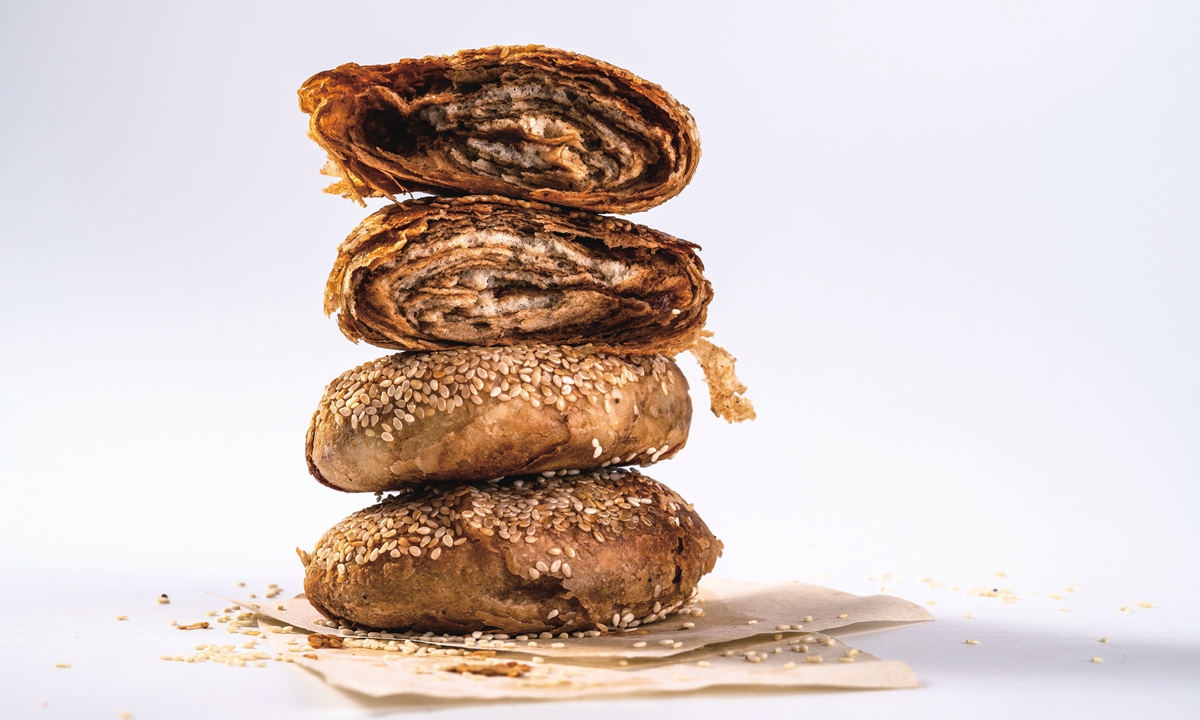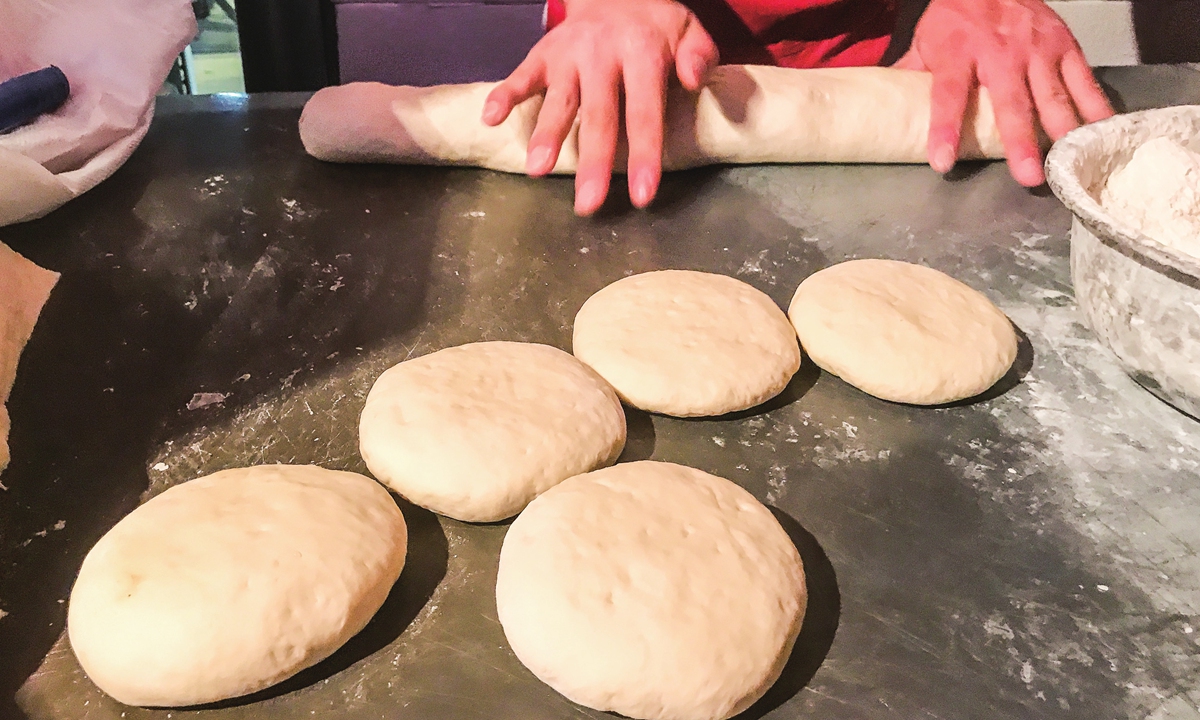
Sesame shaobing, a local snack of Beijing Photo: VCG

A cook makes shaobing in the morning. Photo: VCG
Last week, an article by CNN spotlighted
shaobing, a traditional flatbread in China, as one of the 50 kinds of world's best bread.
"Crack into the sesame-seed crust of a
shaobing to reveal tender layers that are rich with wheat flavor. Expert
shaobing bakers whirl and slap the dough so thin that the finished product has 18 or more layers. The north Chinese flatbread can then be spiked with sweet or savory fillings, from black sesame paste to smoked meat or Sichuan pepper," the article described.
Historical memoriesIn China,
shaobing is a beloved traditional snack that carries rich regional culture and historical memories.
In different regions,
shaobing's cooking skills and flavors exhibit diverse characteristics, not only reflecting the local people's lifestyles and culinary traditions, but also serving as important representatives of regional characteristics.
From the sweetness of sesame
shaobing in Beijing to the duck or lamb
shaobing delights, these century-old flatbreads serve as canvases for the rich culinary culture of the country.
Historical accounts trace the origins of this kind of snack back to the Eastern Han Dynasty (25-220), which has evolved over the centuries to encompass a myriad of varieties.
Blended with sesameThe love for sesame paste among Beijing locals runs deep to their core.
Whenever indulging in hot pot, they insist on dipping them in sesame paste.
Even when enjoying pancakes or cold noodles, sesame paste is a necessary accompaniment.
This culinary devotion has given birth to a signature Beijing delicacy known as majiang (sesame paste)
shaobing.
Majiang
shaobing is made of wheat flour as the base and filled with sesame paste. They are sprinkled with a layer of sesame seeds on the surface and have multiple layers inside.
Nowadays, Majiang
shaobing is not only a daily morning meal for the Beijing locals, but also a must-eat local delicacy for visitors to the city.
Venturing into the northern regions, the youtiao (fried dough sticks)
shaobing is another beloved breakfast staple. Its golden, crispy exterior gives way to a tender interior infused with the delectable crunch of freshly fried dough sticks.
Timeless classicIn Central China's Henan Province, the ingredients for
shaobing are relatively simple, consisting of flour, sesame oil, seasonings, and scallions.
Traditional Henan
shaobing is baked in wood-fired ovens. With a crisp, flaky texture and the aromatic essence of fresh scallions, this timeless classic embodies the essence of home-cooked comfort and aroma.
Zhao, a local Henan resident, told the Global Times that a rustic delicacy can be baked to perfection in traditional wood-fired ovens.
However, in time, electric ovens gradually replaced the iconic wood-fired hearths.
Shaobing can offer a variety of eating experiences.
By accommodating an array of savory fillings, from eggs to ham, vegetables to grilled meats, it will offer a symphony of flavors with every bite.
In the northwestern part of China, the tradition of grazing cattle and sheep has thrived for generations. Among the people of the region, cattle and sheep are the most common livestock, with lamb being a staple delicacy in their daily cuisine.
The lamb
shaobing in the region is supreme, boasting a fragrant, golden crust encasing a succulent lamb filling.
Each bite is a blend of crispy exterior and juicy, flavorful meat.
Strong aroma
In Nanjing, East China's Jiangsu Province, there is a popular saying: "Without duck, there is no feast."
The love for ducks among the people of Nanjing has become deeply ingrained in their daily lives.
With a long history of duck farming, Nanjing's climate is highly conducive to duck rearing.
Consequently, the city boasts a variety of duck-based delicacies, with salted duck being the most renowned.
The locals' penchant for duck consumption is also reflected in its traditional methods of
shaobing preparations.
The duck
shaobing of Nanjing tantalizes the senses with its golden, crispy exterior and fragrant, tender interior, utilizing duck fat as the primary cooking oil.
The crab shell
shaobing is a traditional delicacy of Nanjing, earning its name due to the resemblance to the back shell of a crab both in shape and color.
Prepared by frying dough made with partially cooked vegetable oil until it reaches a crispy texture, it is then combined with water dough to form multiple layers.
The filling is carefully selected from preserved vegetables and fatty pork, and sprinkled with sesame seeds.
Then
shaobing is baked in a special large oven, pressed against the oven wall until it is fully cooked and removed.
Freshly baked crab shell
shaobing emanates a strong aroma even before tasting, and upon biting into it, the layers peel off crisply, leaving a lingering fragrance.
Rustic delicacyCaolu
shaobing is a rustic delicacy originating from Yangzhou, East China's Jiangsu Province.
Cooked with wheat straw as fuel in traditional upright ovens, they are filled with various fillings, boasting a golden hue and a delightful crispiness with a hint of sweetness.
For many elderly residents of old Shanghai, scallion
shaobing represents more than just a street-side snack; it evokes fond childhood memories.
They reminisce about the aroma of scallions wafting through the alleyways of their homes, the long queues at breakfast stalls, and the crispy texture with every bite.
True to its name, the main ingredients of scallion
shaobing are flour, scallions, and oil.
Some vendors also use a combination of lard and vegetable oil to enhance its fragrance.
In addition to the specialty
shaobing mentioned from both northern and southern areas of China, there are countless other varieties of
shaobing, each exuding strong regional characteristics and unique flavors.
"Bread is basically what your culture says it is," says Rubel, the author of Bread: A Global History.
Shaobing, as "one of the 50 world's best breads," stands not only as a culinary delight, but also as a cultural icon that continues to inspire and delight food enthusiasts worldwide.